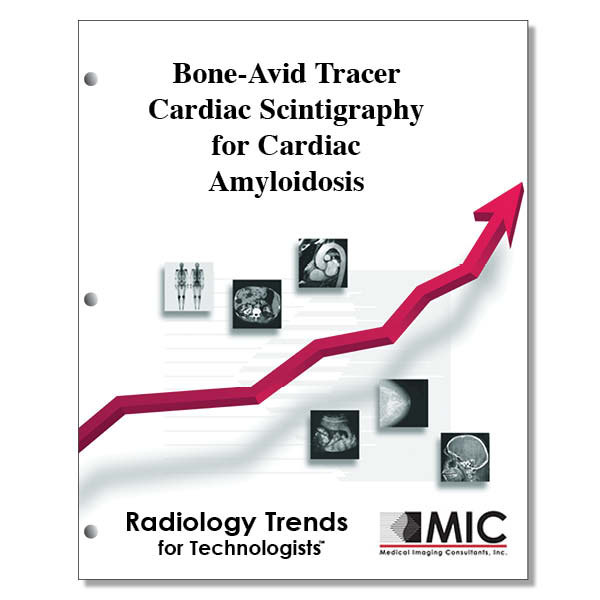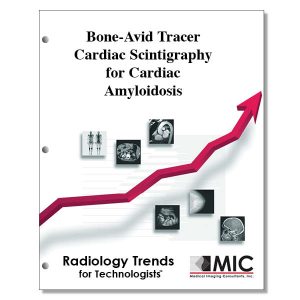

Bone-Avid Tracer Cardiac Scintigraphy for Cardiac Amyloidosis
An overview of cardiac amyloidosis, with a summary of bone-avid tracer cardiac scintigraphy, and an approach to accurate interpretation and reporting of technetium 99m bone-avid tracer cardiac findings.
Course ID: Q00790 Category: Radiology Trends for Technologists Modalities: CT, Nuclear Cardiology, Nuclear Medicine, PET, RRA2.75 |
Satisfaction Guarantee |
$29.00
- Targeted CE
- Outline
- Objectives
Targeted CE per ARRT’s Discipline, Category, and Subcategory classification:
Nuclear Medicine Technology: 2.75
Procedures: 2.75
Cardiac Procedures: 2.75
Outline
- Introduction
- Cardiac Amyloidosis
- Imaging Evaluation of HFpEF in Older Adults
- Noninvasive Diagnosis of ATTR-CA without Biopsy
- Mechanism of Nyocardial Uptake of Bone-Avid Tracers in Amyloidosis
- 99mTc-PYP/DPD/HMDP Scintigraphy for Risk Assessment in ATTR-CA
- 99mTc-PYP/DPD/HMDP Scintigraphy to unravel the prevalence of ATTR-CA in Select at-Risk Cohorts
- Novel Targeted Therapies for ATTR-CA
- Clicical Vignette
- How to Acquire 99mTc-PYP/DPD/HMDP Images
- How to Interpret 99mTc-PYP/DPD/HMDP images: A Systematic Aproach
- Step 1: Perform Quality Control
- Step 2: Confirm the Presence of Rib Uptake as a Check for Appropriate Timing of Scan Acquisition
- Step 3: Distinguish Myocardial 99mTc-PYP Uptake from Blood Pool Activity
- Step 4: Interpret Myocardial Uptake: Visual Assessment and Grading of 99mTc-PYP Images
- Optional Step for Interpretation: Semiquantitative Method of H/CL Ratio at Planar Imaging
- Step 5: Exclude a Monoclonal Process with Serum/Urine Immunofixation Electrophoresis and a Serum Free AL Assay in All Patients with Suspected Cardiac Amyloidosis
- Step 6: Review for Physiologic Tracer Distribution and Extracardiac Tracer Activity
- Challenges with 99mTc-PYP/DPD/HMDP Image Interpretation
- False-Positive 99mTc-PYP/DPD/HMDP Scans
- High Blood Pool Activity
- Recent Acute Myocardial Infarct and Other Myocardial Injuries
- False-Negative 99mTc-PYP/DPD/HMDP Scans
- False-Positive 99mTc-PYP/DPD/HMDP Scans
- Clinical Reporting of 99mTc-PYP/DPD/HMDP Studies
- When to Refer for Further Evaluation Including Endomyocardial Biopsy
- Future: Quantification of Cardiac Amyloidosis with Use of SPECT and SPECT/CT
Objectives
Upon completion of this course, students will:
- understand how amyloidosis affects the myocardiumidentify individuals most susceptible to ATTRwt-CA
- understand the specificity and sensitivity associated with cardiac scintigraphy and amyloidosis
- identify the bone-avid radiotracer that should be avoided for cardiac amyloid imaging
- identify the bone-avid radiotracer previously used for cardiac infarct imaging
- describe potential image findings at one hour post Tc-99m PYP injection
- list image findings that would indicate sufficient time has past
- understand the frequency of ATTR-CA in hospitalized HFpEF patients over age 60 with thickened myocardium
- list the current medications available to treat ATTR-CA
- understand the recommended and required scintigraphy imaging parameters
- identify the only definitive method to confirm radiotracer myocardial uptake
- describe organs visualized if 99mTc PYP were injected beyond 6 hours
- understand how the Perugini score is utilized
- explain how H/CL regions of interest are drawn and placed
- explain how myocardial radiotracer can be confirmed
- list factors that can negatively impact the H/CL ratio
- identify a radiotracer that may be helpful with AL
- identify the test that should be considered for AL positive patients
- understand the physiologic biodistribution of 99mTc PYP/DPD/HMDP
- describe common incidental findings on 99mTc PYP/DPD/HMDP scintigraphy
- describe techniques to differentiate blood pool from myocardial activity
- describe the myocardial uptake pattern visualized on planar imaging
- identify what could be considered in select high suspicion cases when 3-hour cardiac scintigraphy reveals persistent blood pool activity
- understand myocardial infarction and cell death physiology
- understand recent myocardial infarction and ATTR-CA cardiac scintigraphy
- list conditions that can contribute to myocardial uptake with 99mTc PYP
- identify the percent sensitivity of 99mTc PYP/DPD/HMDP for ATTR-CA
- list types of cardiac amyloidosis associated with false negative outcomes
- identify report findings on 99mTc PYP/DPD/HMDP scans that are considered optional
- explain management options for 99mTc PYP grade 0 or 1 gene positive patients
- list SPECT/CT quantitative software programs
